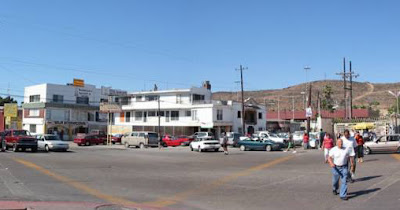Month: April 2016
Estación Federal
Tijuana’s great new old building
There was something about that white pseudo-modernist building at the border. Built in the 1950’s on the busiest corner of Colonia Federal next the revolving pedestrian metal gates that let you in to Tijuana and the rest of Latin America. It was the early 2000s and the neighborhood was booming with activity, it had the hustle and bustle you would expect of any lively neighborhood in TJ. The first thing you heard as you came in through those gates was the loud yell across the street from the “Farmacias” employees wanting to sell you an Anthrax vaccine, and yellow taxis lined the curb picking up tourist for a ride downtown. However, the main commercial activity of Colonia Federal was and still is the used car import business.
The building, also known, as Estacion Federal was originally a gas station that later became an apartment building for Mexican federal employees working at the border. As the years passed, the building emptied and deteriorated until one day the owner’s son decided to open his architecture practice in the third floor. He straightaway made a call to his artist/architects friends to populate the second floor at a very reasonable rent for start-up firms. In a few months the building was full; artists, graphic designers, and architects launching their careers that eventually would enter them into a serendipitous collaboration.
“Estacion Federal was a space of anonymity screened by the life of the city that was happening around us” mentions Daniel Carrillo who had his architecture studio in the building. Like him, every studio/office was experimenting with projects for and about the city as well as about the border, which is only a few meters away. The artist Marcos Ramirez “Erre” and his partner Coco Gonzalez took over the owner’s son space and turned it into Estacion Tijuana – a studio/gallery space that went to became the launching pad for many ideas about city culture and beyond. The entire building became a space to dwell on the urban and cultural conditions from the edge of Mexico, a place of overlap between TJ/SD identity and also an open space for anybody who wanted to express through their work the future of art and urbanism at the beginning of the 21st century in the Americas. The Italian cultural anthropologist Fiamma Montezemolo remembers, “I rarely feel a sense of place, yet when I think of Estacion Federal I felt it as if it was my home. In those years the building and everyone who was there created the opportunity for many cultural projects that probably have continued elsewhere. “ Montezemolo went on to meet writer Heriberto Yepez and architect Rene Peralta during her leisure visits to Estacion Federal and later co-author with them the seminal book “Here is Tijuana” in 2006.
Estacion Federal was a live/work building before that type of hipster spaces were introduced to Tijuana, everybody had a sleeping corner in their studio just in case they had to pull an all nighter or the party(s) of the night before had continued through the next day. Events such as film night, lecture series, after parties and other social events began to be a constant excuse to talk about projects and collaborations between the groups. Monica and Melisa Arreola two twin sisters were introduced to the building when they worked for Techne, an architectural office, decided to rent their own space and open Basica art studio, they later founded “206 Arte Contemporaneo” in downtown and currently are one of the most important independent art galleries for upcoming artists in the city. Not only was Estacion Federal a magnet for local up and coming talent it also attracted artists and architects from San Diego like a group of students from the UCSD art department and Giacomo Castanola a Peruvian architect who had a small studio apartment with his wife, curator Lucia Sanroman who is now a director of a major museum in San Francisco.
And just as it began without a plan, it ended. Everyone had a great time, shared ideas, produced projects, had parties and eventually, without remorse moved on to bigger and better things. As Daniel Carrillo comments “In those days alcohol played a significant role in the construction of events and memories and as the inflection point through which the whole building gravitated from.”
Today, after 10 years of abandonment Estacion Federal is going through another stage of transformation. A group of young entrepreneurs are eager to make of the building a contemporary live/work space as well as the front from where the renaissance of Colonia Federal will develop. Time will tell if this new era of Estacion Federal will promote the original and serendipitous vitality of ten years ago. However, the odds are at its favor if we believe what the great Jane Jacobs once said, “New ideas need old buildings”.
The Tijuana Solar River in Fox News
Thanks to Rebekah Sager of Fox News for the article on our research project to turn the Tijuana River Canal into a power producing infrastructure.
Amigo, colega y mi decano de Woodbury, Norman siempre estuvo apoyándome como profesor y arquitecto. Descanse en paz!
The Tijuana Solar River in the Los Angeles Times
Thanks to Carolina Miranda from the LA Times for the article on our research project to turn the Tijuana River Canal into a power producing infrastructure.





